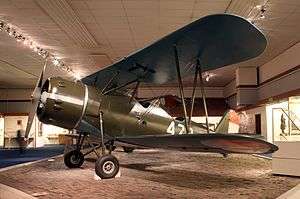Koolhoven F.K.51
| F.K.51 | |
|---|---|
 | |
| Koolhoven FK-51 replica at Militaire Luchtvaart Museum Soesterberg | |
| Role | Trainer, Reconnaissance Aircraft |
| Manufacturer | Koolhoven |
| First flight | 1935 |
| Primary users | Royal Netherlands Air Force Spanish Republican Air Force |
| Number built | 142 |
|
| |
The Koolhoven F.K.51 was a 1930s Dutch two-seat basic training biplane built by the Koolhoven Company.[1]
Design and development
The Koolhoven F.K.51 was the winning design in a 1935 Dutch government contest for a new trainer. Designed by Frederick Koolhoven the prototype biplane trainer first flew on 25 May 1935. The aircraft was an equal-span biplane designed to use a variety of engines between 250 hp (186 kW) and 500 hp (373 kW). It was a two-seater and had a fixed tailwheel undercarriage. The Royal Netherlands Air Force (LVA) ordered 25 aircraft in 1936 and 1937, powered by a 270 hp (201 kW) Armstrong Siddeley Cheetah V radial engine. A further 29 aircraft were later ordered with 350 hp (261 kW) Armstrong Siddeley Cheetah IX engine. The Dutch Naval Aviation Service ordered 29 aircraft each powered by a 450 hp (335 kW) Pratt & Whitney radials. The Royal Dutch East Indies Army bought 38 aircraft between 1936 and 1938 each powered by a 420 hp (313 kW) Wright Whirlwind. The Spanish Republican government ordered 28 F.K.51s, 11 with 400 hp (298 kW) Armstrong Siddeley Jaguar IVa radials and 17 aircraft (designated F.K.51bis) each powered by a 450 hp (335 kW) Wright Whirlwind R-975E radials. Production totaled at least 142 aircraft. Twenty-four fuselages of the F.K.51 were assembled at Aviolanda.
Operational history
While the majority of F.K.51s were employed as elementary trainers within the Netherlands or in reconnaissance roles by the Royal Netherlands Air Force in the Dutch East Indies, twenty-eight were clandestinely sold to the Republican government during the Spanish Civil War, all despite a Dutch embargo on the sale of arms to either side of that conflict. Some of those arriving in Spain were used as light bombers by the Republicans in the Cantabrian region of Spain.[2]
The F.K.51s were in active use in Royal Dutch Flight Schools during 1939–1940 in the training of young Dutch pilots. The majority of F.K.51s were destroyed in May 1940 on the ground by attacking Luftwaffe aircraft.
Operators
Specifications
Data from Combat Aircraft of World War II: New York: MacMillan Publishing Co., Inc.
General characteristics
- Crew: 2 (one observer or student, one pilot or instructor)
- Length: 7.85 m (25 feet 9 1/3 inches)
- Wingspan: 9.00 m (29 feet 6 1/3 inches)
- Height: 2.80 m (9 feet 2 inches)
- Wing area: 27.0 sq m (290.63 sq ft)
- Empty weight: 1,010 kg (2,227 pounds)
- Loaded weight: 1,600 kg (3,527 pounds)
- Powerplant: 1 × Armstrong Siddeley Cheetah IX, 9-cylinder, air-cooled radial piston engine, 261 kW (350 hp)
Performance
- Maximum speed: 235 km/h at 2,280 m (146 mph at 7,462 feet)
- Cruise speed: 215 km/h (133 mph)
- Range: 730 km (454 miles)
- Service ceiling: 5,600 m (18,370 feet)
Armament
- Guns: Two fixed forward-firing 7.9 mm (0.32 inch) machine gun in wings, one similar weapon in a flexible mount in the rear cockpit
Avionics
Provision for one camera
See also
- Related lists
References
- ↑ The Illustrated Encyclopedia of Aircraft (Part Work 1982-1985). Orbis Publishing.
- ↑ Aircraft that took part in the Spanish Civil War
External links
 Media related to Koolhoven F.K.51 at Wikimedia Commons
Media related to Koolhoven F.K.51 at Wikimedia Commons